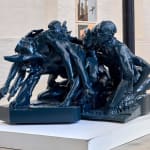 Installation view: Tales for a Stranger, Curated by Azu Nwagbogu, The Warehouse by MARUANI MERCIER, 2023
Installation view: Tales for a Stranger, Curated by Azu Nwagbogu, The Warehouse by MARUANI MERCIER, 2023
 Photo by Tony Hafkensheid
Photo by Tony Hafkensheid
 Photo by Tony Hafkensheid
Photo by Tony Hafkensheid
 Photo by Tony Hafkensheid
Photo by Tony Hafkensheid
 Photo by Tony Hafkensheid
Photo by Tony Hafkensheid
Miles Greenberg
39 x 52 3/8 x 59 in
Further images
On 'Late October':
In 2020, Greenberg staged an elaborate live installation titled Late October, which was inhabited by seven performers, including himself, for seven consecutive hours at Galleria Continua Les Moulins, an hour east of Paris. Perched atop rotating plinths and blinded by white contact lenses, the nude lacquered bodies of the performers revolved slowly above an ice blue basin.
From this performance, Greenberg has gone on to create additional artworks as part of the series: a single-channel film edition, a 3-channel film edition and installation, and 3 new sculptures. Icarus I, Narcissus I, and Orpheus I (all 2021), are Greenberg's first body of sculptural work. Developed as an extension of Late October, this series marks the artist’s first experiments into formally sculptural work. While different in its mode of display, the romanticism of classical sculpture, the rigour of modern architecture, and the nuanced understanding of how energy flows through a body constitutes the foundation of Greenberg’s sculptural practice much as it does his movement work. Titled after young figures of cautionary tales from Greek mythology who suffer calamity due to human fallibility the sculptures represent an archival method of documenting the artist’s performance practice as much as they are their own investigations into art history and its relationship with entropy.
To achieve his visual desire for the erosion that takes place in sculptures naturally over time, Greenberg hacked the software of the 3D scanner to create glitches in the scans of movements. Much like the chance encounters that occur with live performance, this digital manipulation allows Greenberg to capture moments of disruption in the sculptural making process. Milled from a high-density material that could eventually be molded and cast in bronze as positives, the sculptures are works in progress as part of the evolution of Late October and proposals for future work.




